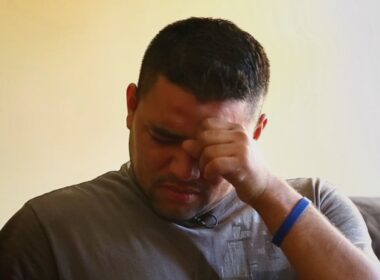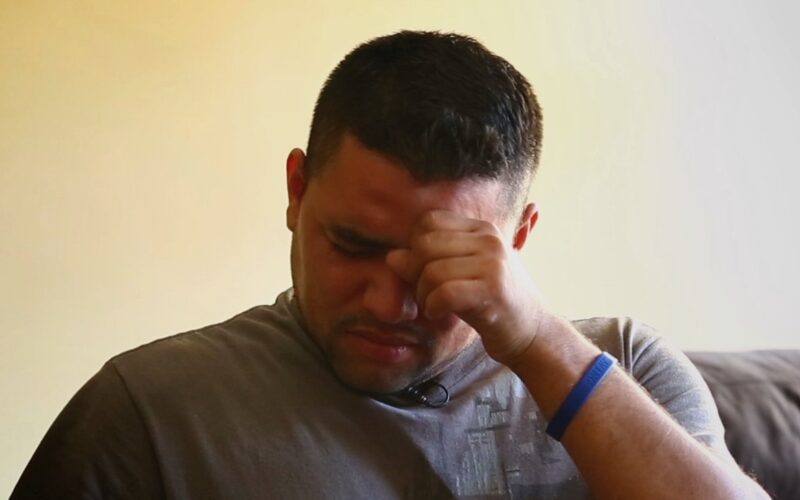Warning: Sensitive content regarding infanticide and maternal suicide.
For many women, pregnancy, birth, and postpartum are challenging and powerful in truly positive ways. Challenges lead to growth: new skills, mindset shifts, reaching out for help, embracing community. The powerful physical and emotional experiences meld and shape a woman’s awe for the beautiful design of her body: to nurture and grow another human being for many months, to bring him or her into this world, and (if breastfeeding) to nourish him or her from her own body.
But a documentary I recently watched explores another reality, one far less talked about, and then only in hushed tones, as if it might be catching. For an astonishingly high 1 in 7 new mothers, postpartum mood disorders (PMADs) color over their rosy pink- or pale blue-hued expectations and hopes for life with their precious babe with a draining gray or even an enveloping black.
You’ve probably heard a fair amount about postpartum depression, but the other less-discussed PMADs include anxiety, obsessive compulsive disorder (OCD), bipolar disorder, posttraumatic stress disorder (PTSD), and psychosis. When the Bough Breaks, a 2017 documentary executive produced by Brooke Shields—herself a survivor of postpartum depression—focuses on postpartum depression (PPD) and postpartum psychosis.
Poignant, eye-opening, and devastating first-person accounts from moms who’ve been there and back again, combined with heart-wrenching testimonies from family members and friends who lost loved one(s), put viewers right there in the thick of a world no one wants to acknowledge, let alone enter, but of which the public needs to be aware.
Что мне понравилось When the Bough Breaks
When the Bough Breaks got many things right. The interviews undoubtedly made the film, putting a human face to postpartum anxiety, depression, OCD, and psychosis, in particular. Insight from perinatal and mental health experts supported the experiences of women who had suffered, and of spouses left behind, (and even that of a man whose sister killed herself and her infant son, among other tragic stories), but the spotlight wasn’t on the professionals… except when it was. The lines in When the Bough Breaks were sometimes blurred, as several of the experts shared their personal experiences with PMADs.
I won’t attempt to summarize the film, but a few things I appreciated most—particularly because these topics are rarely discussed anywhere else—are below.
When the Bough Breaks gives a sense of the scope of the problem and the urgency of raising awareness about PMADs, especially psychosis
Therapist Diana Lynn Barnes of The Center for Postpartum Health helpfully contextualized the oft-repeated ‘1 in 7’ statistic, noting “About 800,000 to 1 million women each year are going to experience some form of mood or anxiety disorder after they give birth” (emphasis added).
Underscoring the vital necessity of educating as many women and healthcare professionals on PMADs as soon as possible, the closing credits of the film began with memorial tributes to two women who were interviewed for the film but took their own lives before it was released. Haiti Harrison, 43, had suffered severe postpartum depression several years prior to her interview and death. Naomi Knoles, 38, who had killed her young daughter during an episode of postpartum psychosis, had agreed to be interviewed for the documentary after being released from serving 10 years of jail time. A picture of her and her new husband smiling in their wedding clothes suggested sunnier days ahead, and hope for a brighter future. The juxtaposition between that picture and the memorial tribute moments later was a true gut punch.
It humanizes women who suffer from postpartum psychosis
Every once in a while, a tragic headline alerts the world that a mother of a newborn, or 3 или 5 children stabbed or drowned or drove her car off a cliff with them. We shudder, horrified, and look away. How could any mother do that to her own children, we wonder in disbelief. That mom was crazy. That could never happen to me, we insist. And yet the tiniest fraction of our hearts and minds may repeat with uncertainty, It couldn’t, could it?
A lawyer representing a woman who killed her seven-month-old son during a psychotic break shared how the grieving father steadfastly supported his wife, explaining that something had happened to her. She had been “the perfect mother” to their two older daughters. Something had happened.
The nebulous nature of that “something” is deeply unsettling, and experts interviewed for the film did little to comfort the average viewer on this point. WTBB discussed some risk factors for PMADs in general, such as prior mental illness, poor support, traumatic birth, difficult pregnancy, and being a single mom. Experts noted that sleep deprivation, the significant hormonal changes that accompany childbirth, and the major identity shift that accompanies motherhood play a role in their development. There was even a passing reference to the possibility of nutritional deficiencies contributing to PMADs.
As for what really causes postpartum psychosis specifically, the film reflects the research to date: There are many, many question marks. There’s a known connection between a personal или family history of bipolar disorder or schizophrenia and postpartum psychosis… but something like half of the women who suffer postpartum psychosis have нет severe mental health history. And, as I’ve learned from other sources, a woman who suffers postpartum psychosis has a 1 in 2 chance of experiencing it again with a subsequent pregnancy (although many women who experience PP psychosis do not go on to have more children) [1].
All of this leaves us asking the question: Why does childbirth make some women go crazy?
There’s a known connection between a personal или family history of bipolar disorder or schizophrenia and postpartum psychosis… but something like half of the women who suffer postpartum psychosis have нет severe mental health history.
When the Bough Breaks distinguishes between other PMADs and postpartum psychosis
Therapist Diana Lynn Barnes explained that for mothers with other PMADs (not postpartum psychosis), they знать something is wrong. They are horrified by the intrusive, scary thoughts they feel unable to control or let go, terrified that they’ll harm their baby or that some other tragedy will befall their family. But women who suffer postpartum psychosis, said Barnes, often don’t recognize that something’s wrong. “1 to 2 in 1,000 [postpartum moms] are unaware that there is something foreign about their thoughts.”
Postpartum psychosis symptoms include auditory and/or visual hallucinations, i.e., seeing and hearing things that aren’t there. They may “hear” voices telling them to harm themselves or their child, as a very small percentage tragically do. Delusions, beliefs with no basis in reality, and often with religious undertones (“my child is possessed” or “my child is the devil”) are prevalent. Women suffering postpartum psychosis may alternate between manic states, with racing thoughts and rapid speech, and depressive states.
But the possibility of postpartum psychosis, including its risk factors, are never discussed in routine prenatal appointments, let alone during discharge education done with spouses or significant others before women leave the hospital. And yet for many (though not all) women with postpartum psychosis, symptom onset begins in those first days and weeks of baby’s life, making the hospital an excellent place to let partners know what to look out for. It’s likely that doctors don’t want to worry new mothers unnecessarily; after all, postpartum psychosis is relatively rare. But as one OB/GYN interviewed for the film explained, postpartum psychosis is a true medical emergency. “We have to treat it the same way we would a heart attack.”
But as one OB/GYN interviewed for the film explained, postpartum psychosis is a true medical emergency. “We have to treat it the same way we would a heart attack.”
Что мне не понравилось When the Bough Breaks
I have only a few critiques of When the Bough Breaks.
Education on treatments was limited
Certainly, the main thrust of the documentary was to draw attention to the prevalence of PMADs, not to provide prescriptive solutions and extended commentary on treatments. The traditional treatments of psychotherapy (“talk therapy”) and antidepressants for postpartum anxiety, depression, and OCD were briefly discussed. But there was no mention whatsoever of bioidentical progesterone support—a cornerstone treatment for PPD well known to restorative reproductive medicine-trained professionals—even though multiple medical professional interviewees mentioned that the massive hormonal shifts following birth can trigger postpartum depression and even psychosis in vulnerable women.
One of the co-producers, who suffered from PPD herself, reported that she hadn’t felt comfortable taking antidepressants. She sought out a nutritionist, who recommended a slew of supplements which helped her substantially. To his credit, a psychiatrist interviewed for the film noted that a pregnant woman’s nutrient stores can take quite a hit, such that she may be extremely depleted by the time of birth and therefore more vulnerable to PMADs.
Missing information on evidence-based treatments
Another co-producer suffered severe prenatal OCD, as well as postpartum OCD, anxiety, and depression. Six years later, she still required an arsenal of heavy-duty psychiatric medications to help her function during the day, including a medication typically given to preserve cognitive function in people with Alzheimer’s. The film featured her story, interwoven with many others, of seeking alternative treatments in order to reclaim her life. During the film, she underwent magnetic transcranial therapy, acupuncture, cognitive behavioral therapy, eye movement desensitization and reprocessing (EMDR).
But there was no mention of exposure and response prevention therapy (ERP), the gold-standard treatment for OCD, or of the fact that cognitive behavioral therapy can actually усугублять OCD by facilitating rumination on one’s obsessive thoughts. Perhaps she and the other producers were unaware, or perhaps she’d tried it previously. But the complete omission of any mention of a key treatment for a debilitating postpartum condition didn’t sit well with me.
No coverage of postpartum psychosis treatment, or of its inadequacies in the US
Additionally, there was almost no mention of the treatment for postpartum psychosis, let alone acknowledgment of the inadequacy of treatment protocols for it in the United States.
For example, in the United Kingdom, women suffering from postpartum psychosis are routinely “sectioned” together with their babies on designated Mother Baby Units (MBUs). On these MBUs, women are medicated, as they are in the US, but they are также encouraged to care for their babies, participate in therapies and support groups, and other forms of уход за собой, all under constant supervision for safety.
By contrast, in the United States, women who experience postpartum psychosis are held on general psych wards and separated from their babies, forcing them to wean from breastfeeding and preventing them from bonding with their child [1]. For those suffering from delusions that their baby has been kidnapped or died, this forced estrangement only affirms their paranoia. The production team of When the Bough Breaks might argue that this is a topic for another documentary, but I wish that at least one interviewee had shared something of her experience.
[I]n the United States, women who experience postpartum psychosis are held on general psych wards and separated from their babies, forcing them to wean from breastfeeding and preventing them from bonding with their child [1]. For those suffering from delusions that their baby has been kidnapped or died, this forced estrangement only affirms their paranoia.
There was very little hope in When the Bough Breaks
Few would have the expectation that such a film as When the Bough Breaks would end happily, especially when the credits section begins with memorial tributes. Still, when I looked around the circle of interviewees who gathered together to share their stories just before the film ended, I was struck by their lined, worn, and haunted faces. There were few smiles, and most looked as if they still carried heavy emotional burdens daily. I heard the слова that “With help, you CAN recover,” and yet, save for two women, I saw little evidence of healing, or of redemption of their suffering. That was most sobering of all.
I’d love to watch a follow-up film sharing the stories of women who came out on the other side of these experiences with resilience. I’d like to hear more about protective factors against PMADs, and effective evidence-based therapies ,especially for those women whose PMADs are refractory (unresponsive) to antidepressants. There would surely be a smaller pool to draw from for such a film, but I can’t help thinking that it’s the companion film many women need.
Yes, PMADs occur with alarming frequency. But they don’t have to have the final say. It seems that our friends across the pond in the UK understand that. Maybe a follow-up film should explore what they know that we (as yet) don’t.






